
You’ve read articles about up-and-coming communications channels and whether you should incorporate them into your nonprofit outreach strategy. You’ve certainly seen pieces praising the benefits of digital marketing and lamenting the shortcomings of direct mail (or vice versa). But, the fact of the matter is, the channels you employ will have little impact on your outreach strategy if the messages you send through those channels are subpar.
That’s where nonprofit storytelling comes into play.
Crafting a strong narrative that explains your mission, why it’s so crucial, and how donors and volunteers can help is key in making a case for supporting your nonprofit. However, without clear guidance around how to structure that narrative, you can easily end up with a rambling, incohesive cluster of text that’s more confusing than anything.
That’s why we’ve created this comprehensive guide to nonprofit storytelling, in which you’ll explore the following points:
- The Importance of Storytelling for Nonprofits
- How To Identify and Build Your Nonprofit’s Story in 5 Steps
- When and Where to Use Nonprofit Storytelling
- 7 Tips for Effective Storytelling for Nonprofits Using Digital Marketing
- Top Nonprofit Storytelling Examples to Inspire You
At DNL OmniMedia, we not only offer nonprofit technology consulting but nonprofit marketing consulting services as well. Because of that, after we cover how to write your nonprofit’s story from start to finish, we’ll discuss a few tips to keep in mind when sharing that story via digital marketing.
The Importance of Storytelling for Nonprofits
For many supporters, the decision to give to a nonprofit isn’t just a financial one. Instead, it’s driven by emotion– their connection to your cause and their belief that your nonprofit will advance it.
That’s where your nonprofit’s story comes into play. Stories:
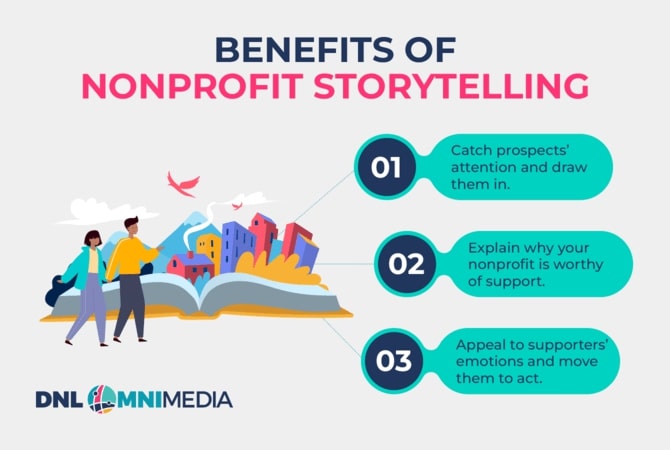
- Catch your prospects’ attention and draw them in to support your nonprofit initially.
- Add context to why your nonprofit is worthy of support.
- Appeal to your supporters’ emotions and move them to act.
More so than data alone, stories create an emotional connection between your nonprofit and its supporters, laying the groundwork to begin forging lifelong relationships. But, that’s only if you craft an effective story and plan for sharing it.
How to Identify and Build Your Nonprofit’s Story in 5 Steps
Just as you carefully crafted your nonprofit’s branding guidelines to convey your organization’s mission and values, you want to take equivalent consideration when writing your nonprofit’s story.
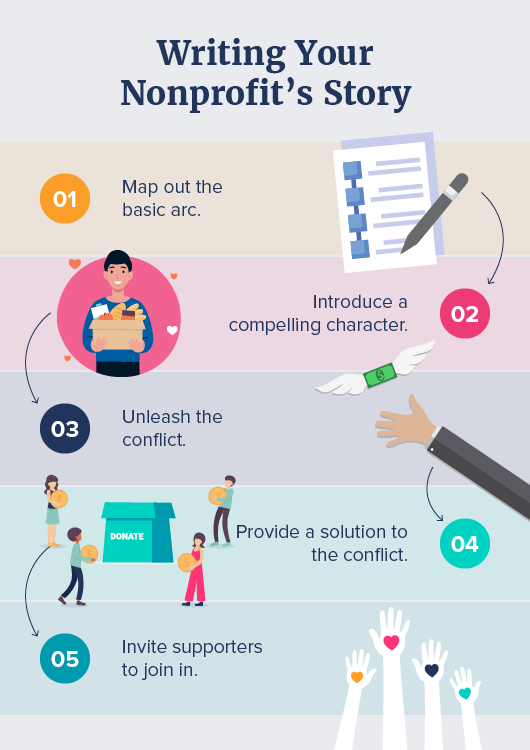
It’s crucial to outline key elements from the characters to the general flow before you begin writing. Let’s walk through five steps to start telling your story from a strong foundation.

1. Map out the basic arc of your story.
Before you get lost in the details of your nonprofit’s story, map out its basic arc. Your story’s arc is the overall path it will follow, generally broken up into three main points:
- The Beginning: This is where the main characters and basic details about your challenge are introduced.
- The Middle: This is where the challenge reaches a peak or climax, and your characters learn, grow, and take action against the challenge.
- The End: This is where the characters overcome the challenge and the story ends with a happy resolution.
Your story’s arc should be very broadly defined. Rather than fully describing each key point or detail in your story, you’ll want to compile the main ideas and focus on the order in which those ideas occur.
So for example, let’s say you’re mapping the arc for a story featuring a volunteer. The beginning would focus on the volunteer learning about your nonprofit, the middle would focus on the volunteer signing up to help and confronting the hardships of your mission, and the end would focus on the volunteer looking back at a day of work that made a difference.

2. Introduce a compelling character.
In your arc, you mapped out the general flow of your nonprofit’s story. But, that arc doesn’t progress on its own– the characters you introduce drive the story forward.
Center your story around a character within your nonprofit’s orbit. Any of the following would be great characters for your story:
- Board members
- Staff members
- Volunteers
- Donors
- Constituents
The idea is that you should build your story around an individual, rather than your nonprofit itself. This not only allows your story to progress forward, but it also centers the story about the work you do around those who fuel it rather than your organization. You want supporters to feel motivated by your story, and choosing the right character allows you to show them the impact that they can have.
Lastly, be especially mindful with how you choose to discuss your characters, especially if you’re depicting constituents. You want to accurately depict the individual and their needs, without infantilizing or misrepresenting them.

3. Unleash the challenge.
Once you’ve chosen the general layout and star, it’s time to begin filling in the details and writing your nonprofit’s story.
Begin your story with a general introduction to your character and organization. Then, unleash the challenge– or the conflict– that your character is going to confront for the remainder of the story.
This challenge will be closely related to your nonprofit’s mission. For example, if you’re a food bank, the challenge would be food insecurity in your area. If you’re a wildlife preservation nonprofit, the challenge would be diminishing habitats and decreasing wildlife presence.
When you discuss this problem, provide some context surrounding why it’s such a crucial issue to understand and combat. With the food bank example, you’d discuss not only that there is food insecurity in your area, but also who it impacts and how it does so.
For example, perhaps 1/3 of your local population is food insecure, defined as not having consistent access to the food needed to support a healthy lifestyle. In your area, this may take the form of people not having access to healthy food that’s within walking distance, or parents having to skip meals to help feed their kids.

4. Provide a solution to the conflict.
Next, you’ll want to provide a solution that ties in both the main character and your nonprofit’s efforts, with both working together to overcome your main conflict.
For example, you might discuss how the fundraising work of volunteers and nonprofit staff members raised crucial funds that paid for a certain amount of food distributed in your community. Or that the outreach efforts of a specific volunteer, using resources provided by your nonprofit, led to the preservation of much-needed wildlife habitat.
While it’s important for supporters to understand the gravity of your mission, it’s just as important for them to see that it can be achieved. Showing them that there is a solution to the problem and that your nonprofit is working alongside supporters to bring that solution to life, is key.

5. Invite supporters to join.
Last but not least, remember that the point of your story isn’t to simply get supporters to listen, but to get them to contribute. Think about what you want supporters to do after they read your story– whether that’s donating, signing up for a volunteer shift, calling their local representatives, or simply telling their friends and family.
Then, wrap up your story with a call to action! Ask readers to get involved through and provide a step-by-step explanation for how to do so. This is especially impactful if you can link directly to the online page– donation form, volunteer sign up, event sign up, etc.– where the supporter can take that specific action.
When and Where to Use Nonprofit Storytelling
Now that you’ve written your nonprofit’s story, you need to share it at optimal times and places to inspire as much support for your cause as possible. The timing and platforms for sharing your story depend on factors like organizational objectives, target audience, and available resources.
Here are some guidelines for sharing your stories for maximum impact:
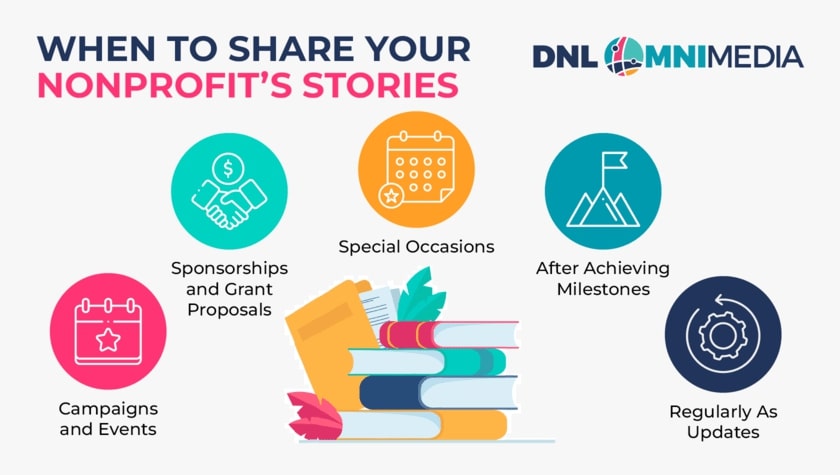
- During Fundraisers and Events: Inspire donors and event attendees to give by emotionally connecting them to your cause. This will help them envision their potential impact on your beneficiaries.
- Sponsorship Proposals: For companies, a big part of corporate social responsibility (CSR) is finding causes that connect with their values. Share your nonprofit’s stories in your sponsorship and grant proposals to form emotional connections with potential corporate partners.
- On Special Occasions: Aligning storytelling with relevant national or international days (like World Mental Health Day, Earth Day, or Breast Cancer Awareness Month) can increase relevance and engagement.
- After Achieving Milestones: Sharing success stories or other updates after reaching certain milestones demonstrates the impact of your nonprofit’s work and encourages continued support.
- Regularly, Through Newsletters and Updates: Regular, story-based updates can maintain engagement, communicate impact, and build long-term relationships.
Where you share these stories matters just as much as when you share them. Consider whether you’ll post them on social media, your blog, email newsletters, annual reports, or somewhere else to connect with supporters.
In any case, your nonprofit should tailor its storytelling approach to fit its specific goals and audience. Remember to always be authentic and sensitive in the stories you tell, ensuring they honor the privacy and dignity of anyone involved.
7 Tips for Effective Storytelling for Nonprofits Using Digital Marketing
Once you’ve written your story, it’s time to share it with supporters far and wide. While you should incorporate more traditional media channels into your strategy, such as direct mail, we recommend creating a comprehensive digital marketing strategy as well.
This is because digital media– whether social media, email, or your website– is the main medium for connecting with your supporters in 2021 and beyond. More and more supporters are giving via the internet, or even their smartphones, and it’s up to you to reach those supporters where they spend time.
Bonus! Team DNL recently hosted a webinar with Blackbaud that was all about using technology to tell your nonprofit’s story. Check it out here.

Consider the goal of the campaign.
When building the digital marketing strategy that you’ll use to share your story, begin by defining the overall goal of the campaign. This goal is what you want to accomplish by the end of the campaign, and will likely fall within one of three categories:
- Raising funds
- Raising awareness
- Stewarding supporters
You’ve already written your story, and the call-to-action included at the end will point you toward your goal. From there, every choice you make about your digital marketing campaign should advance that mission– from the outreach materials you create to the technology in which you invest.

Create a content library.
More than likely, you’ll want to use multiple channels for your digital marketing strategy (more on this in the next section). To make translating your story across multiple channels as easy as possible, assemble a content library that contains a variety of assets relating to your story.
In your digital content library, include:
- Copy: This is the written version of your story. Include long and short variations, as well as a breakdown of key messaging for one to two-line communications.
- Photography: Seek out variety in your photo assets, in both the scenes depicted and the dimensions of the photos. It’s likely that every channel you use, whether different social media platforms or your email marketing platform, will require a unique set of dimensions for images. Having those on-hand ensures your strategy won’t be limited due to not having the right images.
- Video: These assets perform particularly well on social media and your website. Video assets can come from a variety of sources, whether live streams, Zoom calls, or fully-produced packages.
If your story includes other digital media assets, such as audio files or infographics, include those in your content library as well. You’ll use these assets to build out a messaging calendar across your various digital media channels in a way that makes sense for your audience.
Remember that content can be both time-bound (for example, assets marketing a one-time event) or evergreen (your nonprofit’s overall story). Assign materials to your various storytelling efforts accordingly.

Grow your story across multiple channels.
When incorporating digital media in your storytelling strategy, layer a variety of channels in your plans.
Some of your supporters will interact with multiple marketing channels, while others will only interact with one or two at most. Using multiple channels allows you to reach a wider audience. Plus, each supporter will be likely to see your story more than once, increasing the likelihood that it sticks with them and motivates them to take action.
Consider using any of the following channels in your digital storytelling strategy:
When layering marketing channels in your strategy, choose the channels that your audience interacts with the most. You can look at data from past outreach and fundraising campaigns to see which channels are most popular.

Segment your audience to share relevant stories.
Think of the diversity represented in your supporter base. You have volunteers, donors, major donors, board members, advocates, and more. Within these groups are individuals who range in age, gender, profession, and preferred communication methods.
Considering the wide range of characteristics in your audience base, it makes sense that you shouldn’t share the same story with all of your supporters en masse. Instead, you should write different stories (or, frame your main story in different ways) to appeal to different segments of your nonprofit’s audience.
So, let’s say you’re telling the story of individuals who support your nonprofit. Tell the story of a volunteer to your volunteer audience, the story of a donor to your donor audience, and so forth.
This segmentation also applies to the communication channels you use. For example, suppose your social media audience on Facebook is largely made up of older supporters. In that case, you can tailor your story on Facebook to focus on the impact of large donations.

Adapt your story for different platforms.
While you may be telling the same story across your various platforms, that story shouldn’t necessarily be communicated in the same way.
Adjust your story to align with the platform it’s shown on. For example:
- On social media, you’ll want to tell the story in a more image-heavy, eye-catching way. Supporters are scrolling through the networks quickly, so you need strong visuals to catch their attention. While you can include a few paragraphs of text on Facebook and Instagram, you’ll be confined to just 280 characters on Twitter.
- While both email and blog posts are ideal for sharing the text version of your story, blog posts can feature longer copy. On the other hand, email newsletters should feature concise, quick versions of the story.
This is where your content library will come in handy, as you’ll already have the necessary assets to adjust your story to align with each platform.

Track the success of your story.
Once you start sharing your story across the various marketing channels you’ve chosen, the work isn’t done. Track specific metrics related to how well your story is received by supporters, such as:
- Open Rate: How many supporters open your email or text communications?
- Engagement Rate: How many supporters click on a blog post, like or share a social media post, or otherwise engage with your story?
- Response Rates: How many supporters call, text, email, or otherwise reach out to your nonprofit after having read your story?
- Conversion Rates: How many supporters take the desired action, such as donating or signing up for a volunteer shift, once they read your story?
If your story is underperforming with your audience, there are a variety of changes that you can make. For example, you might adjust the wording, share it on new platforms, or use different wording to convey the intended emotion more effectively.

Work with a nonprofit marketing consultant to elevate your strategy.
Writing your nonprofit’s story, coordinating the telling of that story across multiple mediums, measuring success after the fact– effective nonprofit storytelling involves juggling a variety of elements at one time.
If this seems like too heavy a lift for your team, consider partnering with a nonprofit marketing consultant. This partner can offer services such as:
- Copywriting
- Content management
- Print and web design
With both industry knowledge and an understanding of your nonprofit, this team member will help you put a comprehensive strategy in place to ensure your nonprofit’s storytelling goes off without a hitch.
Plus, if you partner with a firm such as DNL OmniMedia, you’ll access nonprofit technology consulting alongside the marketing services. Team DNL can both formulate your storytelling strategy and ensure your tech stack is up to par to carry it out.
Top Nonprofit Storytelling Examples to Inspire You
We’ve discussed the steps of writing your story and the best practices to keep in mind when sharing it using digital media.
Now, let’s walk through three examples of strong storytelling to inspire your team, each pulled from our guide to the top nonprofit websites. Each of the following organizations have clearly defined their stories and are successfully sharing them via digital means. Let’s dive in!

The North Shore Animal League
The North Shore Animal League America (NSALA) is the largest no-kill shelter in the country, and uses its story to raise funding to support its shelter and adoption programs.
This story is clearly shown across NSALA’s digital presence, specifically when it comes to the organization’s website. On the homepage of its website, star-worthy images of adoptable animals are immediately visible, followed by a two-sentence preview of the organization’s story focusing on the challenge and solution aspects.
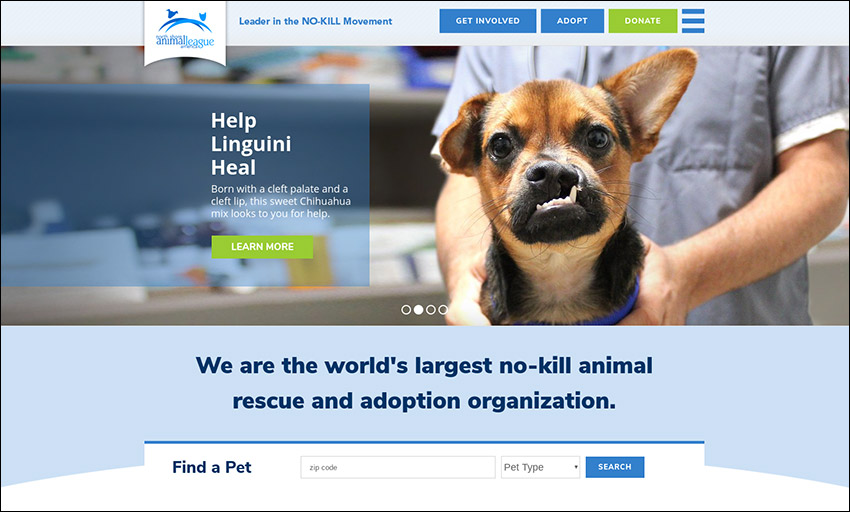
To learn more about the various ways that NSALA shares its story using tech tools, explore this case study.

Mustard Seed Communities
Mustard Seed Communities’ mission is to provide residential care to children and adults with developmental and physical difficulties. Working with DNL OmniMedia, Mustard Seed’s website was carefully crafted to share the story of its mission far and wide.
Mustard Seed Communities focuses its storytelling on the residents that live at its facilities, each of whom is given an individual page to shine. On these pages, they briefly discuss when the resident moved into the facilities and how they’ve progressed while there. Then, the page principally focuses on fun facts, such as the likes, dislikes, and interests of the individual.
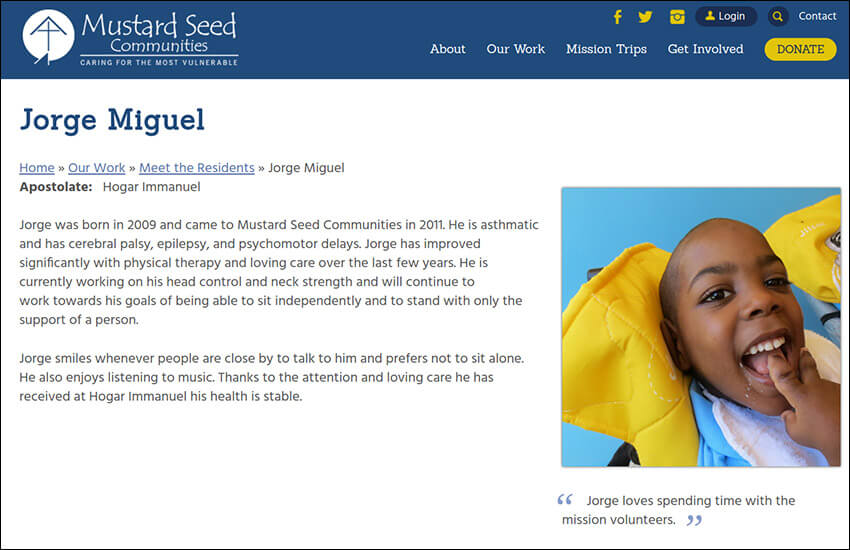
These pages allow supporters to learn about the individuals that their support will impact, and can go a long way when making the case for donations. To learn more about their website build, check out the case study here.

Save The Children US
Save The Children US provides much-needed food and other supplies to children across the world. Save the Children’s story is spread across its website in multiple areas, including:
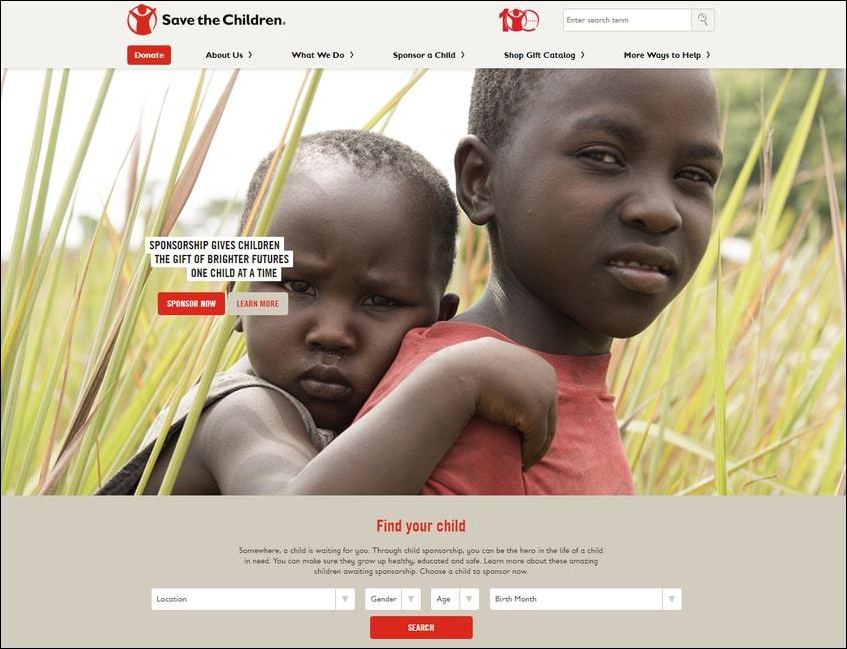
- News clips
- Longer-form blog posts
- Informational pages
- Quick one-liners containing key stats and figures
This information, while comprehensive, is organized in an easily navigable manner. Site visitors can easily explore the organization’s story without issue.
Additional Resources
How you tell your story is just as important as the information you choose to include within it. With these steps, tips, and examples, you’ll be on the fast track to crafting an effective nonprofit narrative. And, if you’re seeking help writing that story or sharing it effectively using technology, you can always reach out to Team DNL for assistance.
In the meantime, review these additional nonprofit storytelling and branding resources:
- Nonprofit Marketing Consulting: Overview & 6 Top Picks. Wondering what it’s like to work with a nonprofit marketing consultant to elevate your strategy? Review this resource to learn more.
- The Comprehensive Guide to Nonprofit Branding. Your nonprofit’s story needs to align with your overall branding guidelines. Read this guide to ensure the two resources are cohesive.
- Nonprofit Website Design Projects: The Comprehensive Guide. Your nonprofit’s website is a core tool for sharing your story. Review this guide to crafting a website from the ground up.


